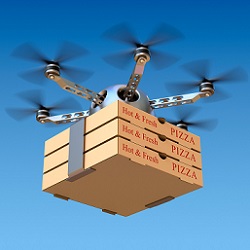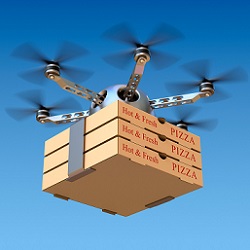
In June, Amazon announced it was close to being able to offer for package deliveries by drone for its Prime Air service. That same month, Uber said it plans to test food delivery by aerial drone in crowded cities. And drone delivery company Flytrex already touts the ability to deliver drinks via unmanned vehicle on the golf course.
Despite such announcements, drones are not crowding the skies over major cities and population centers just yet. But that may be about to change.
After several years of hype, widespread drone usage may be close to ready for primetime.
Drones increasingly are being deployed in a number of compelling real-world use cases. These use cases have drone companies and enthusiasts bullish that, no matter what happens, there are serious real-world applications for drone technology today and in the near future that will disrupt life and business as we know it.
Drone-Assisted Photography/Surveying
“Traditionally, we’ve seen drones being used for photography and surveying,” says Eric Peck, CEO of Swoop Aero, an Australian company that delivers medical supplies via aerial drone. “It’s all about data capture, because data really is driving the ability to generate economic growth at the moment.”
From construction to insurance to real estate to agriculture, the ability to survey and photograph wide swaths of land and hard-to-reach locations with aerial drones is valuable to companies. For instance, high-quality photos and videos from different aerial angles can better showcase residential properties up for sale, more effectively highlighting elements that appeal to buyers.
Aerial footage shot by drones is less expensive than manually taking aerial footage from a helicopter. One drone photographer interviewed by The Baltimore Sun noted the cost differences: “I can drive up to my destination, plug my equipment in, and be done [photographing] in five or 10 minutes,” said Jack Hardway, owner of a drone photography firm. “It doesn’t cost me $5,000. It costs me pennies to put that thing in the air.”
The cost is one benefit. The ability to collect more visual data from more angles than from a traditional camera also is important.
A Santa Monica, CA-based company called DroneBase uses unmanned aerial vehicles (UAVs, or aerial drones) to offer, among other services, aerial surveying of building rooftops to give insurance companies an easy way to assess damage related to claims. For insurance and surveying purposes, aerial drones offer the ability to cover more ground while traversing more areas and angles than might be possible (or affordable) with traditional manned aircraft.
Other use cases include surveying and monitoring progress at construction sites, and performing simple regulatory inspections for commercial real estate properties. Aerial drones are even used to fly around warehouses and find supplies or products faster and more accurately than humans do.
Aerial drones also come in handy in agricultural applications. They offer a dual benefit in this context. First, drones are used to survey fields. Instead of having to traverse hundreds or thousands of acres on foot or by vehicle, farmers have the ability to fly drones faster and more efficiently over large areas. That helps reduce the time it takes to monitor fields, as well as reducing the amount of fertilizer and pesticides they must use to maintain crops.
“We identify diseases and pests and fungus and weeds in the crop at an earlier stage,” U.K. farmer Colin Rayner told German broadcaster DW. Some drones are even used to spray fields with pesticides. According to DW, Chinese drone company DJI sold 20,000 pesticide-spraying drones in 2018 alone.
In all of these examples, the drones are being piloted remotely by experienced professionals. For instance, DroneBase claims it has the “largest network of professional drone pilots in the world,” but they are all still human beings.
Right now, this gives an advantage to bigger companies that can scale and capture cost advantages that offset the expense of human pilots.
“While the market for drone photography and data capture is massive, it’s close to saturated right now, both in terms of platforms and operators,” says Peck of Swoop Aero. “We’ll see a lot of movement as big players gain advanced regulatory approvals [for more extensive drone applications], which allow them to gain a cost advantage based on economies of scale and drive smaller operators out of the market.”
That dynamic has led companies like Swoop Aero to look at use cases for drones that involve delivering high-value commodities.
Drone Doctors
One high-value commodity that makes a lot of economic sense to deliver via drone is medicine.
The market need is clear: when it comes to perishable medical samples or life-saving vaccines, time is of the essence, and few technologies are better at traversing crowded or hard-to-reach areas than aerial drones.
Swoop Aero operates drone networks that deliver medicine quickly in countries like Pacific island-nation Vanuatu, which is composed of dozens of islands. Often, the deliveries take a fraction of the time they would if conducted by boat. Vanuatu is a country in which, the United Nations Children’s Fund (UNICEF) estimates, a full 20% of children under five do not receive all the vaccines they need because of the logistical challenges around medicine delivery.
Last December, Joy Nowai of Vanuatu was, according to the company, the “first child in the world to be vaccinated with a vaccine delivered by a drone under a commercial contract,” thanks to Swoop Aero. The drone travelled 30-plus miles to deliver the vaccine, while keeping it at the optimum temperature during the entire trip.
After the successful delivery, the company conducted a further four-month trial in Vanuatu, which Swoop Aero says led to continued work with the country’s Ministry of Health.
Swoop Aero is now preparing to deploy additional drone networks to countries that lack easy logistical access to life-saving medicines and vaccines. One of the company’s networks is being deployed in the Democratic Republic of the Congo, in collaboration with that country’s Ministry of Health and local non-governmental organizations.
Another company, California-based Zipline, just launched a series of drone distribution centers in Ghana designed to deliver vaccines and medications to the country’s population 24 hours a day. The company says health workers placing orders for medications via text can expect the requested medicine to be delivered within 30 minutes.
This type of aerial delivery at scale is not only well suited for geographically inaccessible areas. Earlier this year, logistics company UPS, in partnership with California-based drone startup Matternet, launched a pilot program to deliver medical samples around the campus of WakeMed, a not-for-profit health care system in Raleigh, NC. According to Business Insider, such samples used to take up to 30 minutes to deliver due to traffic congestion, but using drones, the deliveries now take just over three minutes.
“Transport is a clear opportunity commercially,” says Peck. “We are focused on last-mile logistics for high-value commodities, predominantly in healthcare. It’s a market which is forecast to grow in size from close to zero right now, to be worth over $10 billion in the next seven years.”
Drones are not just flying to areas where people find it hard or time-consuming to go; they are swimming there, too.
In 2018, submersible drones built by Texas-based Ocean Infinity worked together to survey parts of the ocean floor inaccessible to humans. The goal was to find the remains of ships that had gone missing. The company succeeded in discovering the wrecks of an Argentinian submarine and a South Korean commercial vessel, long after hope was lost that concerned parties would learn the fate of the disappeared craft.
Companies are desperately trying to make it possible for consumers to receive deliveries by drone of products that would normally be delivered by mail or manned vehicle.
Like their aerial counterparts, underwater drones are packed with sensors that collect data and share it with company control centers. Instead of putting humans at risk in dangerous underwater conditions, the drones go deeper underwater and stay under longer than human-manned vessels could, transmitting back valuable data all the while.
The unmanned underwater drone approach has been so effective that one company tasked with finding Malaysia Airlines Flight MH370, the Dutch geosciences company called Fugro NV, reportedly “plans to do away with some [human] crews entirely.”
The Future of Drone Delivery
There are plenty of intriguing real-world applications for drones at present, but that has not stopped companies from salivating over the holy grail of drones: last-mile logistics. Companies such as Amazon are desperately trying to make it possible for consumers to receive deliveries by drone of products that would normally be delivered by mail or manned vehicle.
While some companies focus on delivering high-value goods via unmanned or semiautonomous drones, last-mile logistics at scale requires near-full autonomy. To deliver most or all products at scale, drones from a company like Amazon will need have the ability to fly themselves short distances with little to no human involvement.
That means building highly sophisticated, reliable types of artificial intelligence (AI) and machine learning into delivery drones. These AI-powered systems must be able to visually recognize and physically respond to real-world obstacles with a high degree of accuracy and speed.
That could take some time, Keith Lynn, a program manager for Lockheed Martin’s autonomous drone racing competition, told The New York Times. “Right now, autonomous drones are a thing you’d only find in labs, being pioneered by a small, niche audience.”
A big reason for that is because autonomous drones struggle to make sense of visual information, particularly at high speeds, in part because of shortcomings in the sensors they utilize. Also, the faster the drones fly, dive, or drive, the more difficult it is for today’s algorithms and cameras to process images at the speed required to recognize (and avoid) obstacles.
Aero Swoop’s Peck is optimistic advancements will lead to drones having greater autonomy in the near future. “Over the next five to 10 years, we are going to see increasing levels of full autonomy used across all aspects of aviation,” he predicts.
Hamilton, I.
Amazon drone deliveries are coming, but Jeff Bezos still missed his own deadline for airborne logistics, Business Insider, Jun. 6, 2019, http://bit.ly/2kJWNcv
Holley, P.
Uber plans to start delivering fast food via drone this summer, The Washington Post, Jun. 13, 2019, https://wapo.st/2m46EK9
Thompson, F.
Next generation farming: How drones are changing the face of British agriculture, DW, Jul. 19, 2019, http://bit.ly/2kviDAk
Waseem, F.
Howard drone users search for opportunity as ‘the skies open’, The Baltimore Sun, July 7, 2016, http://bit.ly/2mit76q
Wilke, J.
A drone program taking flight, Amazon, Jun. 5, 2019, https://blog.aboutamazon.com/transportation/a-drone-program-taking-flight
Wise, J.
Underwater Drones Nearly Triple Data From the Ocean Floor, Bloomberg Businessweek, Jun. 7, 2019, https://bloom.bg/2kobrpq





Join the Discussion (0)
Become a Member or Sign In to Post a Comment